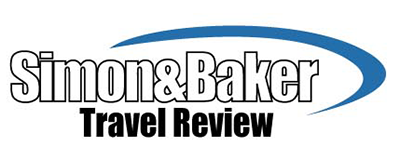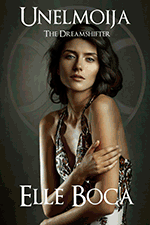Luxury Travel Review

Luxury is workout facilities on safari
By Elena del Valle
Photos by Gary Cox
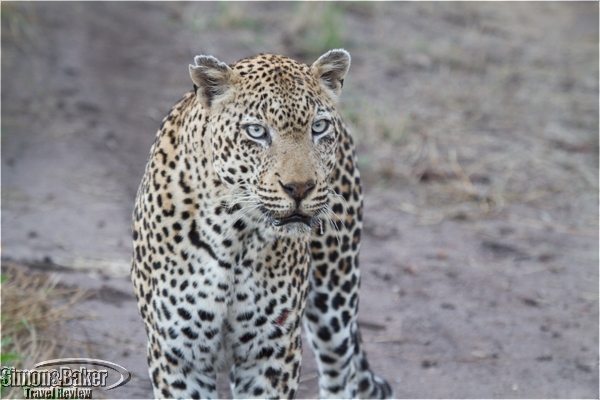
We go on safari to see nature. Thankfully that does not always mean missing out on exercise.
While on safari safety is a priority. Frequently wild animals, some of them dangerous, roam freely near the luxury lodges where guests stay. They may stroll through the property. This means that in many places staff escorts are required for guests at night and sometimes in the early morning around dawn. At the dozens of properties where I have stayed, with some exceptions, jogging and running were discouraged or not allowed. This makes exercising beyond in-room basic stretching difficult.
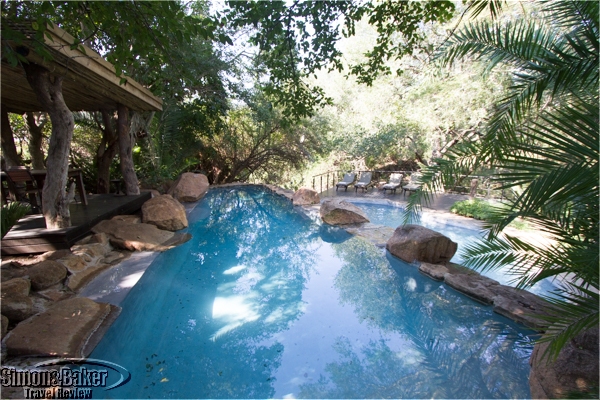
The two swimming pools at Singita Ebony were large enough for laps.
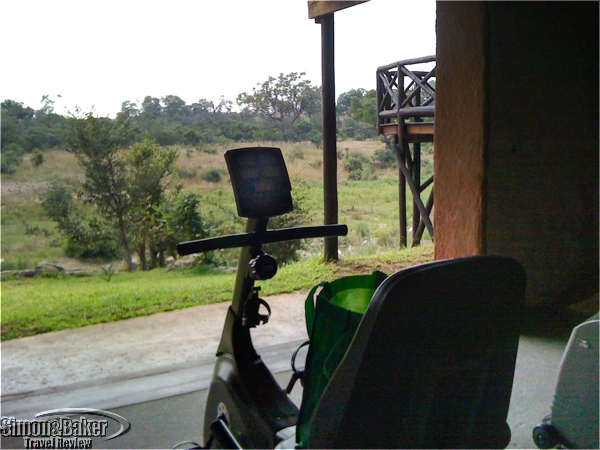
The workout room at Lukimbi was open air.
I suspect that many fitness aficionados smile with pleasure on discovering somewhere to safely stretch their legs while in the African bush. Yet running, jogging and exercise in general were difficult or not possible in many of the Big Five properties I have visited, especially in those without electric fences surrounding the property itself. That is why I remember the lodges with a full length swimming pool or a dedicated workout area with particular fondness.
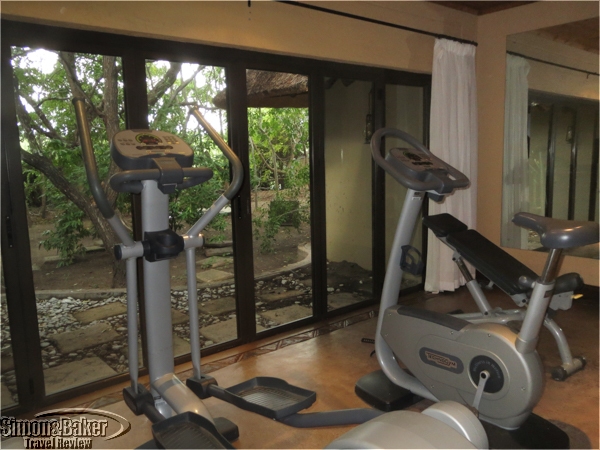
While at Fitzpatrick’s Lodge at Jock Safari Lodge we had access to the Jock exercise room a short drive away.
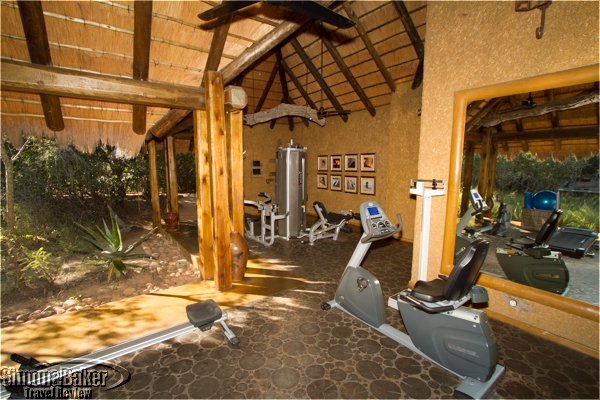
The open air workout area at Camp Jabulani was covered
While on safari days fly by in a blur of activities, mainly twice daily game drives and sometimes guided walks. Early mornings and three course dinners make finding time to exercise a challenge. For those willing to do so having a pool to swim laps, treadmill, elliptical machine or free weights can be the ultimate luxury. On our 2017 trip to South Africa, several five star safari lodges, Lukimbi Safari Lodge, Fitzpatrick’s Lodge at Jock Safari Lodge (www.jocksafarilodge.com, +27 (0) 13 010 0019, Fax +27 (0) 86 601 9961, Reservations@jocksafarilodge.com), Sabi Sabi Earth Lodge, Singita Ebony, Simbambili Game Lodge, and Camp Jabulani, had fitness facilities.
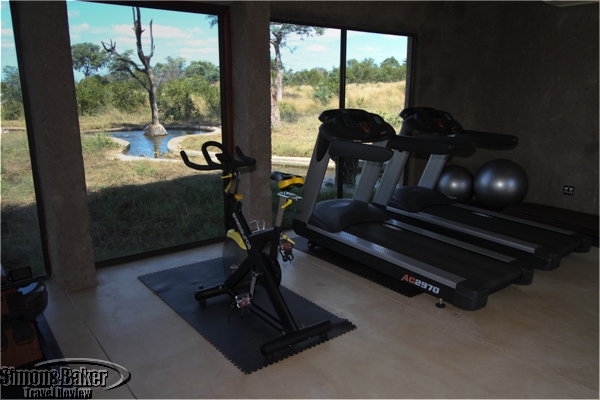
The air conditioned exercise room at Sabi Sabi Earth Lodge with a pretty view was a favorite.
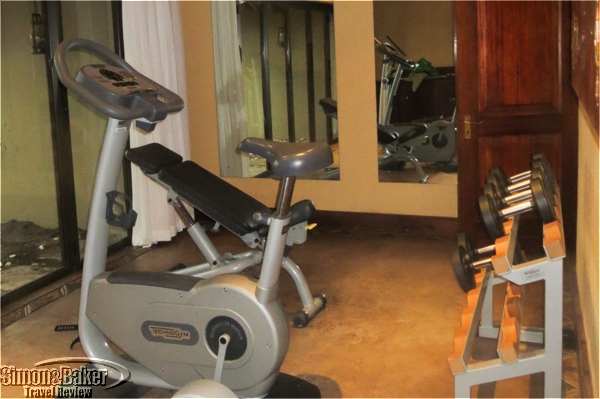
The workout room at Jock’s had a rack of dumbbells and a slanted bench
Lukimbi, on the southern end of the well known Kruger National Park, had an open air fitness and treatment room facing the lawn and bush across the Lwakahle River. The pool was visible from the workout room as well. The room housed a workout space with weights station, Running Machine, Cycle, and Step Machine.

I liked the glass wall at the air conditioned Singita Ebony workout room, which was in the same building as the spa.
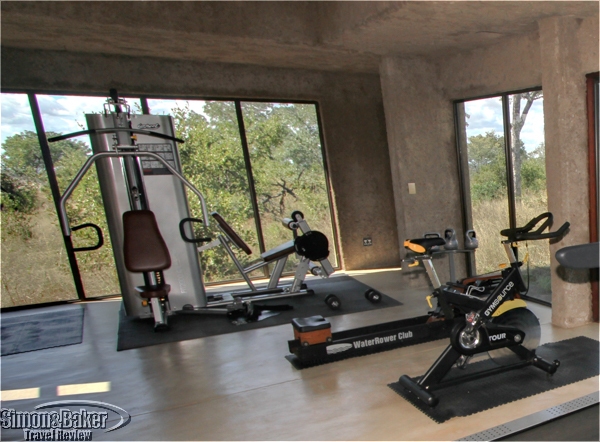
Earth lodge featured a variety of aerobic machines and a resistance circuit machine.
As a guest at Fitzpatrick’s I had access to the small workout room within the Jock’s Safari Lodge 150 square meter spa building. The sister properties were within a two minute drive. Anelda, our friendly host, kindly drove me over from Fitzpatrick’s to Jock’s. The visit also provided me an opportunity to browse in the curio shop as Fitzpatrick’s was too small for its own shopping space. When I was ready to return I asked the staff person at Jock’s to call her. Within minutes she picked me up. Thanks to the room’s glass wall I enjoyed bush views during my workout. A thirty minute careful jog along the property’s wet pathways (it rained during most of our three night stay) rounded out my morning.
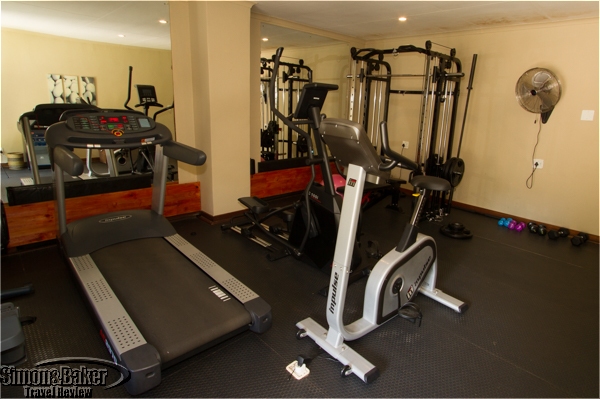
Simbambili had an indoor workout room in the same building as its meeting room.
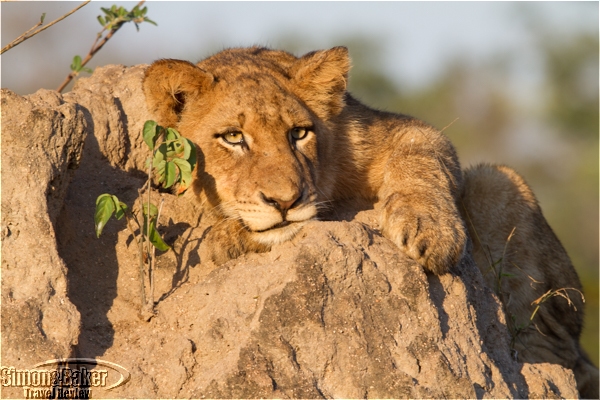
While this cub could exercise safely in the reserve the humans had to stay indoors.
Sabi Sabi Earth Lodge, one of our favorite properties on that trip, had a dedicated air conditioned 50 square meter (5 meter by 10 meter) workout room in a stand alone building. Some of the workout room’s glass walls faced the bush and a water feature. I especially enjoyed watching the many birds attracted by the water feature in the morning during my workout. The fitness room housed two treadmills (Impulse AC2970), spinning bicycle (Gym Source Tour), water rower (Water Rower Club), Multigym (Impact FIT200 Classic), freestanding bench, Kettle Bells in two kilo increments ranging from four to eight kilos, two Pilates balls, three yoga mats. Amenities include chilled sparkling and still mineral water, Powerade, hand towels, sanitizing spray and paper rolls. I later found out there is an adjoining shower for guests who wish to freshen up.
“The beauty of the location of the gym is such is that it does not impact on the main lodge but is hidden away and also blends into the environment,” said Heath Thompson, lodge manager, via email when asked what makes the gym stand out. “The structure is built with the same concept as that of the main lodge with a natural, organic type structure and the majority of the gym is glass, with views of a waterhole – allowing for uninterrupted views of the bush veld whilst training or exercising. We have often had remarks from our guests who have spotted elephant drinking from the waterhole. The bird life is also phenomenal due to the availability of a water source.”
A fan of bush walks he added, “Whilst this performs the mainstream basis of keeping fit (from all that delicious food of course), there is also the opportunity to go on one of our environmental awareness walking safaris, so whilst this is not traditionally an ‘exercise’ based excursion and the idea behind this is to expose guests to a safari from a different angle and experience the “small stuff” that one generally misses whilst out on a an open vehicle, it does nonetheless necessitate walking (up to 1.5 hours). So whilst gaining a holistic experience of the African bush from a walking perspective, one’s body also benefits from the walking.”

The workout machines at Camp Jabulani were under thatch next to the massage area.
Singita Ebony’s fitness room shared a building with the spa. The air conditioned space had wood floors, a row of machines, and a bush facing glass wall. In addition to our en suite heated private plunge pools (a favorite) Singita Ebony also had two common area swimming pools. Although the water was chilly it was wonderful to have a midday swim to offset the blistering summer heat.
“Singita Ebony Lodge has a very unique bush spa with gym attached,” said Chantelle Maritz, co-manager, Singita Ebony Lodge. “The two rooms at the spa are comfortable and decorated alongside the classic safari look with sliding doors that open. The gym side is a rock wall with large glass windows.”
The 49 square meter (11.3 meter by 4.3 meter) gym was stocked with individual size bottled water and coconut water, towels, television and two showers (shared with spa guests).
As of May 2018 the gym offered the following weights in kilos: 10 to 20 sizes, kettle bells in 4, 8 and 16 kilos, medicine balls in 3 and 5 kilos. There were: foam roller, five floor mats, yoga block, two wellness balls and Technogym equipment: bench, two treadmills, two exercise bicycles, multi-functional trainer, shoulder press machine, chest press machine, cable station, leg extension, and vertical traction machine.
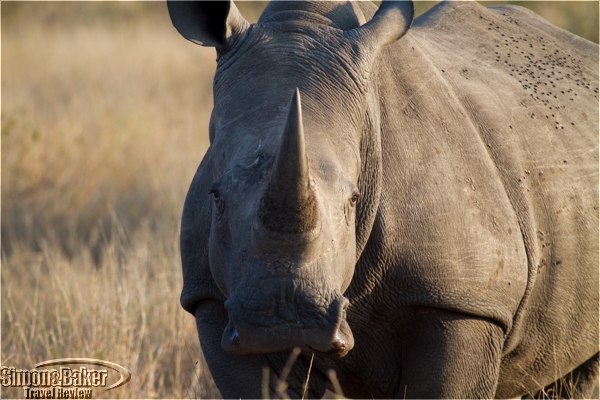
While seeing the animals is still the best part being able to exercise is healthful.
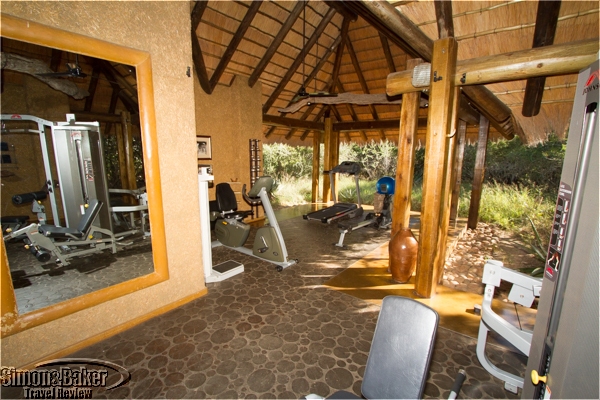
Camp Jabulani had a steam room and sauna.
Our three-bedroom, three bathroom Zindoga Villa accommodations at Camp Jabulani were so spacious and comfortable I had little need to spend time in the common areas with the exception was the dining room at meal times. The pretty 53 square meter open air workout area, equipped with: Johnson multipurpose machine, static bicycle and Johnson rowing machine, Trojan treadmill, six sets of free weight Trojan dumbbells and Detecto scale, was inviting. There was also a new looking six square meter sauna with a glass wall. Had we spent another night at the property I would have made time to work out; and should we plan a future safari trip to the area Camp Jabulani will be high on my list, among other reasons, for its workout facility. For more South Africa safari properties with workout facilities when we were there see Safari properties that offered exercise facilities among favorites.
New book inspired me to expand my travel bucket list
By Scott S. Smith*
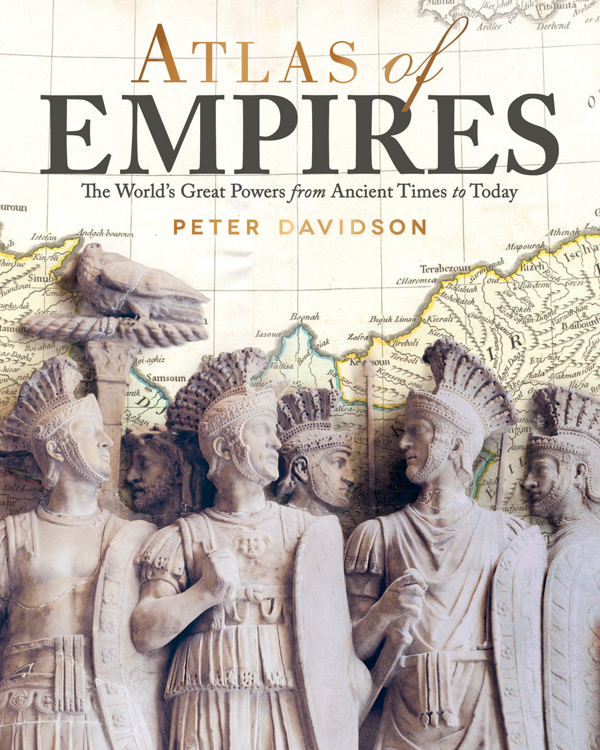
Atlas of Empires
I’ve been hooked on visiting destinations that played some important role in history from the moment I first set foot on foreign soil at 19 in what was then called West Germany (where my jaw stayed dropped for two years just looking at the ancient architecture). I’ve been fortunate in having had a chance to write extensively about the events and leaders of the past, and I’ve learned that there is no book, film, or website that can replace the 3-D experience of being at ground zero of some world-changing moment (usually served by a cutting-edge local museum that can thrive at a place of pilgrimage for history buffs).
That said, Atlas of Empires: The World’s Great Powers from Ancient Times to Today by Peter Davidson (Fox Chapel Publishing, $19.99), a 240-page paperback published in 2018, comes close to being a time machine that immersed me in its pages. When I read history in hard copy, I’m used to having to highlight the text I think I will need when I write (or if it’s an overview covering a topic I think I know, I listen to CDs when on long drives or stuck in traffic, usually from the estimable Teaching Company). I found myself underlining passages on almost every page of Davidson’s tome.
What I don’t tend to do with books is study the graphics, unless they involve battlefield movements. But this Atlas was a revelation of global history for me. Its text and pictures prompted me to make connections between empires and events, reminding me of facts I had forgotten, and enriching my future travels, even illuminating my past trips. Davidson (co-author of Milestones of History and a director of documentaries for the History Channel) wrote a remarkably concise yet thorough summary of the major events of world history, describing how each civilization grew and the causes for its disappearance or its evolution into today’s nations.
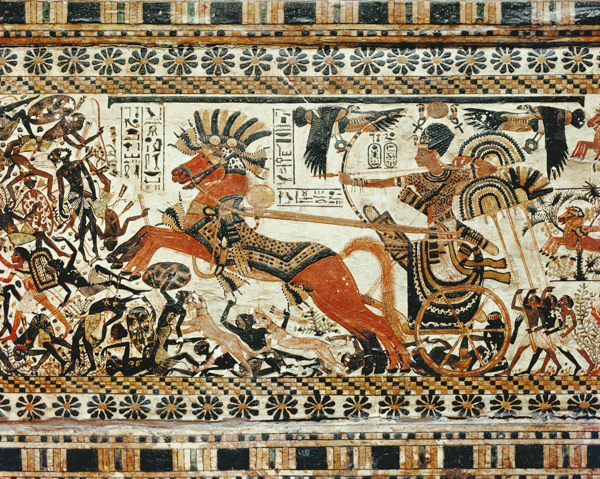
Circa 2005, detail showing the destruction of the black Africans painted on the box of stuccoed wood, from the tomb of the pharaoh Tutankhamun. (Image by ©Robert Harding World Imagery/Corbis)
It’s one thing to recall that Egypt’s Old Kingdom, whose pharaohs built the first pyramids, lasted five centuries, B.C. 2686 to 2181 (BCE for the politically correct). But even though I had made my first book report on Egypt in third grade and had the honor of having the country’s head of antiquities, Zahi Hawas, as our guide through the stunning Cairo Museum, I had forgotten that the Middle and New Kingdoms also lasted a half century each. The thumbnail sketches of the great pharaohs highlight their astonishingly long reigns. For example, Thutmose III, who was constantly on the front lines and expanded the empire to its farthest reaches, died after 54 years on the throne. Rameses II built many of the great monuments during his 67 years in power. Yet Tutankhamun, whose treasures are touring the United States as I write, only lasted nine years as pharaoh.
The chapter on Persia is a reminder of how well some far-flung ancient empires were managed, despite staggering challenges in communications, logistics, and cultural differences. The godfather of the study of modern business management, Peter Drucker, was once asked who the greatest leader in history was. His answer surprised many (and implied it’s been downhill since): Cyrus the Great, who became leader of the Persian tribes in 559 B.C. and died in battle in today’s Kazakhstan in 530. He fostered goodwill and loyalty by promoting religious tolerance and is mentioned 22 times in the Bible, having freed the Jews to return to Israel in 538 after 48 years of captivity in Babylonia (Cyrus is said to be the only gentile who was ever declared a “messiah”). With Iran constantly in the news for the past four decades, it’s helpful to know how it fits into the Persian empire it identifies with. That stretched north to include what is now Uzbekistan (the city of Samarkand is one of the world’s great and largely undiscovered destinations), east to encompass Afghanistan and Pakistan, and west to take in part of modern Greece, Turkey, and Egypt.
The text is full of facts that surprised me: Sparta’s population was 80 percent slaves (compared to Athens’ 30 percent); celibacy was only insisted on for all clergy by the pope in 1074; 240,000 were killed in the final battle for the Aztec capital of Tenochtitlan; the Inca empire, which stretched 3,000 miles, was managed without writing; 20,000 of the African American slaves who fought against the colonists during the American Revolution left with the British afterwards; in 1839, the Chinese dumped 20,000 chests of opium into the sea, which had been delivered by British traders, so the United Kingdom’s government retaliated by sending gunships to annex Hong Kong and open five new ports.
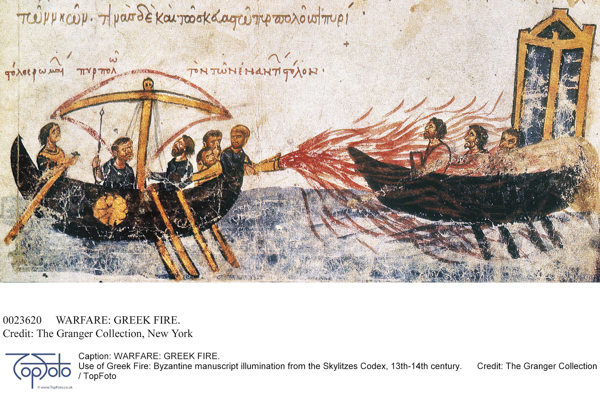
Use of Greek Fire: Byzantine manuscript illumination from the Skylitzes Codex, 13th-14th centuries.
While the book’s art is often eye-catching (such as statues depicting Genghis Kahn’s mounted warriors near Mongolia’s capital of Ulaanbaatar, Byzantine sailors spraying Arab ships with mysterious “liquid fire”), the reason this volume is essential for me as a serious history traveler is the maps. By using different shades to denote where and when empires expanded, even newbies to historical geography can quickly grasp the flow of conquest or assimilation. There are also symbols that show what the most important economic resources were for the region, including slaves, obsidian, and hemp. Gold made Mansa Musa of the Kingdom of Mali in northwest Africa the wealthiest man of all time with $400 billion in today’s money (ruling from 1312 to 1337 A.D. BCE). Davidson is particularly good at working in business history, such as how and where tiny Netherlands created a far-flung commercial empire by taking advantage of new technology and financial systems.
The maps make clear the vast territory that the Mongols conquered (from eastern Europe east, including most of the Middle East, Central Asia, Russia, and China), where precisely the first global empire, Spain’s, was located; and what it meant for the sun to never set over land where the British queen reigned. The maps that break down Chinese history helped me as a non-specialist understand the territory ruled by the dynasties of the Qin, Han, Tang, Song, Yuan, Ming, and Qing, and how they were culturally different (under the Ming, Admiral Zheng’s large fleets sailed as far as Africa. I think Gavin Menzies makes compelling arguments for his foray across the Pacific in 1421: The Year China Discovered America).
 The Second British Empire (click to enlarge)
The Second British Empire (click to enlarge)
Also valuable is the recommended list of books for each chapter for readers who would like to know more about the people, stories, and meaning of history without being drowned in the details of scholarship. I plan to give this book the time it deserves by taking it on a trip to read the short chapters and study the maps in spare moments, like waiting in line at the airport. If I wasn’t making historical destinations a priority before, I have a much longer bucket list now that I finished reading it.
*Photos courtesy Fox Chapel Publishing
Our Artisanal Dark Chocolate Tasting
Article by Margot Liebman
Photos by Aaron Lubarsky*
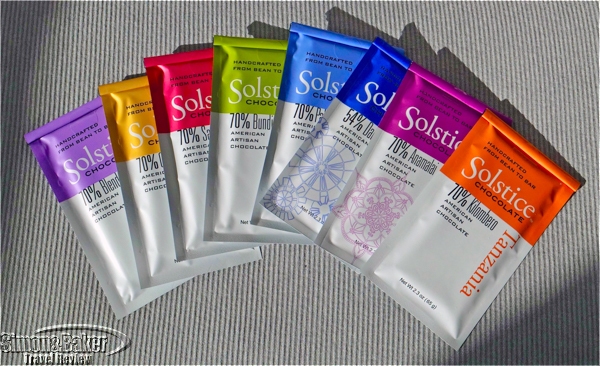
The selection of Solstice bars I tasted.
When a small box appeared in the mail one afternoon in late December, I was pleasantly surprised. Inside were eight sleek bars of chocolate from Solstice Chocolate, a premier American artisan chocolate maker in Salt Lake City, Utah (Solstice Chocolate, Inc., 469 West Century Drive, Salt Lake City, Utah 84123, +1- 801-871-5935, www.solsticechocolate.com, info@solsticechocolate.com). Each bar was dressed in a smooth, thick paper and foil package that resealed at the top to keep the chocolate inside fresh; and color coded with bold type indicating its origin, cacao percentage, and brand name.
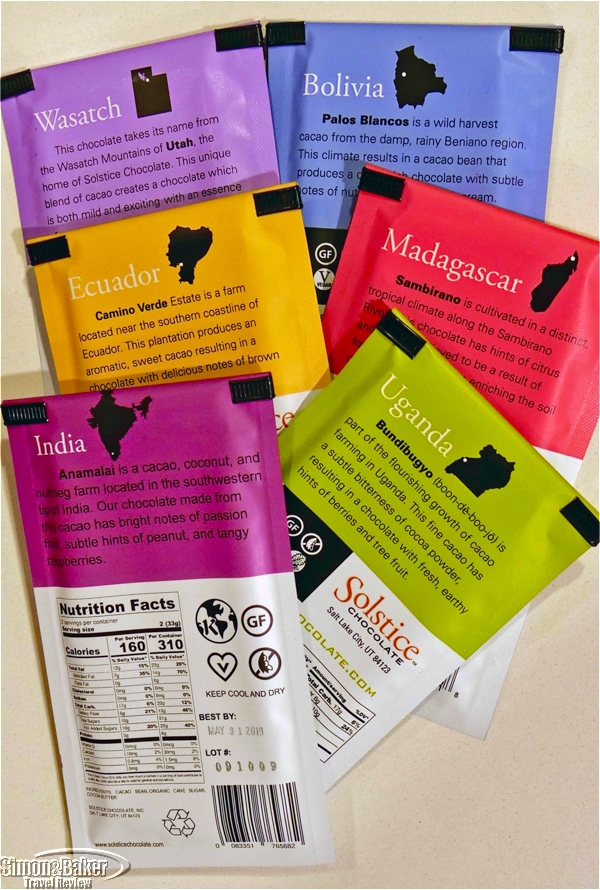
The packaging described the source of the cacao beans used to make it.
The Solstice website, describes its products as a “bean-to-bar chocolate” that is handcrafted using the finest single origin cacao from all over the world. With names like India, Madagascar, and Tanzania, it was easy to know where a bar’s beans originated. I imagined that each bar would taste quite different, but quickly learned that the differences were subtle. From bean delivery to getting packaged bars out the door Solstice allotted between seven and ten days for production.
“Our chocolate is known for having bright flavors. Our origin varieties range from fruity to earthy; there’s something for everyone,” said DeAnn Wallin, owner, Solstice Chocolate when asked by email what distinguishes Solstice products from those of other chocolate makers. “Our bars stand out, each having its own personality, so to speak, and each can be distinguished from the others. Our style is also reflected through uncluttered packaging with bold colors.”
As a milk chocolate lover, it took me a while to appreciate the dark, intense flavor of the Solstice Chocolates. Most of the bars tasted earthy and bitter, and were almost waxy in consistency. Save the one bar of milk chocolate, all the bars boasted 70 percent cacao. That said, it was fascinating to savor the different notes in each bar, and to think about the harvesting conditions that must play a role in how the beans grow.
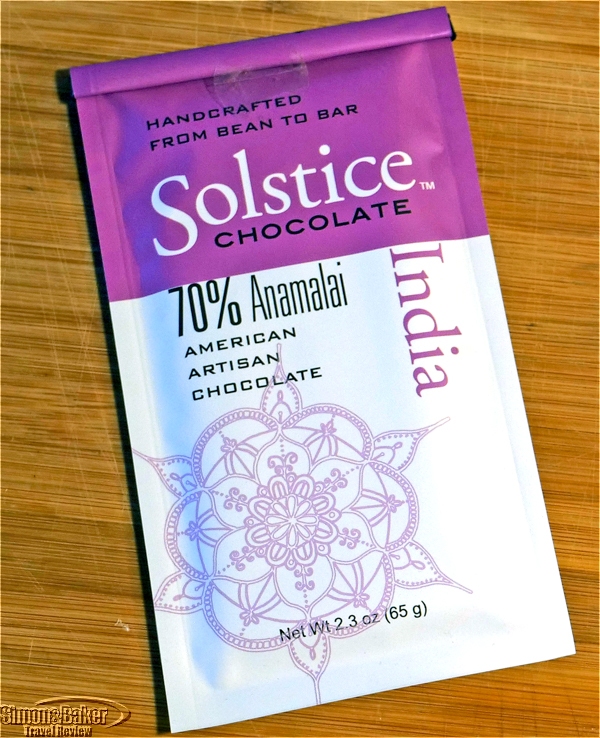
The bars displayed the percentage of cocoa.
I first tasted Uganda, which had a bitter tone that left hints of berries on my palette. Second I sampled Ecuador. When I looked on the Solstice website, I saw that Ecuador was handcrafted from cacao grown by Camino Verde Estate, a farm located near the southern coastline of Ecuador with an unusual fermentation method. It was a strong flavor, with sweet aromatics and hints of banana and cream. The next one was Bolivia. At first bite, a wave of nostalgia rushed over me. I quickly realized the bar reminded me of baking chocolate. It tasted of honey, nuts, and favorite memories of making chocolate desserts.
When asked how her company selects the beans Wallin replied, “Networking through trusted sources. We receive cacao samples on a regular basis. If one interests us then we test it, research it and decide if we want to invest in using it.”
Tanzania was fruitier, smoother and a bit more tart than the previous bars. Wasatch was exciting, and had an unexpected spiciness. India was more complex than some of the others, with tangy flavor notes and hints of earthy spice. Madagascar was more of a slow experience, as most of the flavors came to me a few moments after the piece had already melted on my tongue. There was a strong citrus tone, and when I looked at the Solstice website I learned that those flavors are believed to be a result of former fruit plantations enriching the soil during French Colonial times.

The bars were molded with a sunburst shape in the center of each square.
For my last delicious morsel, I saved the milk chocolate. The package indicated that the bar was 54 percent cacao, where the dark chocolates were 70 percent cacao. The flavor was denser, and not as milky in texture as other milk chocolates I have sampled. I tasted subtle hints of graham cracker, but that may have been wishful thinking for a s’more.
Solstice Chocolate bars were lovely to look at. The packaging employed a celebratory color palette, and each bar was clearly labeled. A white dot on the country of origin map on the back of the package indicated where the beans were farmed. Knowing where the beans were sourced helped me enjoy the chocolate bars in a different way. I found myself looking for subtleties and thinking about the story of each chocolate in an interesting way. Based on my experience, I would recommend Solstice Chocolate to my friends who like dark chocolate.
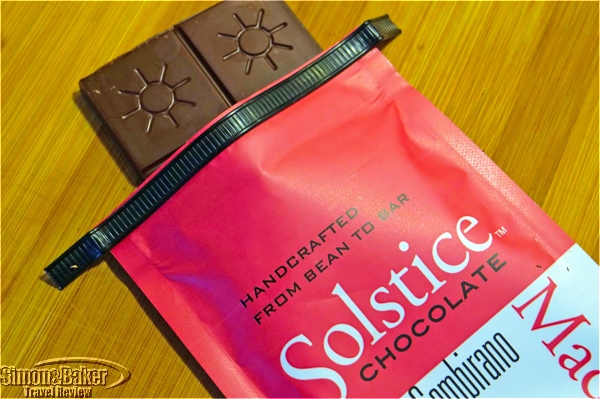
The packaging included a closure to reseal it after opening.
Editor’s note: We asked two of our contributors who are dark chocolate lovers to sample Solstice chocolates in February 2018 as well. Here is what they found.
We compared the Solstice Chocolate Madagascar 70 percent Sambirano, a 2.3 ounce bar, with a well-known premium European dark chocolate bar with a similar cacao content and were stunned by the difference in the two. We blended each with hot water and tasted them side by side. Where the hot drink made from the European bar was almost lumpy in texture, had a milky undertone and muted flat flavor the Solstice hot drink was smooth in texture and taste, with a layered tart flavor that was rich with just a hint of pleasant bitterness. It remains memorable after several weeks.
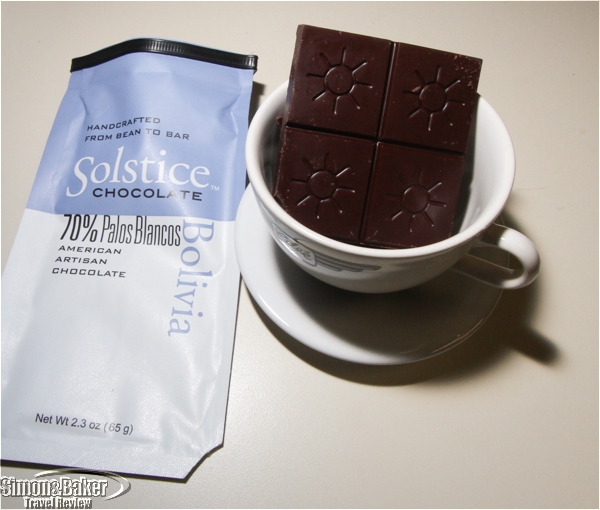
Melting the chocolate into a couple of ounces of hot water created a delectable drink.
We also liked the Bolivia 70 percent Palos Blancos, which came in a 2.3 ounce bar. For a contrast we also sampled the Solstice Chocolate Coconut American Artisan White Chocolate, a 2.2 ounce bar. The coconut burst through immediately past the sweet and buttery texture of the butter colored pieces to become an instant favorite.
We appreciated the simplicity of the ingredients. The Sambirano and Palos Blancos ingredients were organic cacao bean, organic cane sugar and organic cocoa butter. The white chocolate was made with cocoa butter, whole milk, organic coconut, organic cane sugar, and pure vanilla extract.
*The final photo is by Gary Cox.
Vehicle Signal Booster Overcame Cellular Dead Zones
Article and photos by Gary Cox

The weboost Drive Sleek Vehicle Signal Booster Kit
Cellular reception in Palm Beach County, Florida for our carrier varies from great to non-existent as we drive around during the course of a weekend, running errands and visiting the beach. Dropped calls are common, and there are places where the signal is so weak that a call cannot be completed. That was why we took advantage of the opportunity to try out the new Drive Sleek Vehicle Signal Booster Kit from weBoost (3301 E. Deseret Drive, St. George, Utah 84790, +1-866-294-1660, https://weboost.com, support@weboost.com). The .55 pound device was designed and assembled in the United States with foreign parts, according to the box.

The box contained a detailed manual and a number to call for help.
Our kit contained an antenna with a magnetic base, a signal booster, a 12 volt power plug, a cradle for the phone and the cables to connect them together. The parts were labeled with numbered stickers that designated the installation procedure. I placed the antenna on the rear deck of our mustang convertible and ran the cord into the trunk. The booster’s Velcro like attachment and some cable wraps made it simple for me to affix it to the lining in the trunk behind the backseat. I was able to fit the cables up and around the seat, tucked out of the way for the most part, except for the jump to the center console where the power plug resides.
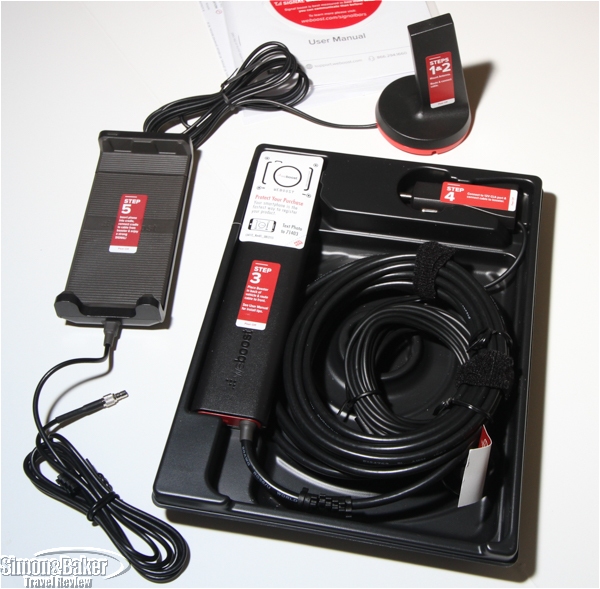
The components had numbered stickers showing the installation order.
The cradle came with an attachment to fit the vents on some cars, but was just not practical in the vents on the mustang. The vent mounting (a little split cone with a magnetic back) helped keep the cradle from sliding off the center console. The cone on the back of the cradle fit into a cup holder and stayed put under normal driving conditions. The power plug must be disconnected when not in use as it continues to draw power even without the car running. A light on the cradle indicates that it is powered up. I prefer to unplug it rather than risk that in a rush I might leave it hooked up and return to a dead battery. It is not clear how long it would take to run the battery down.
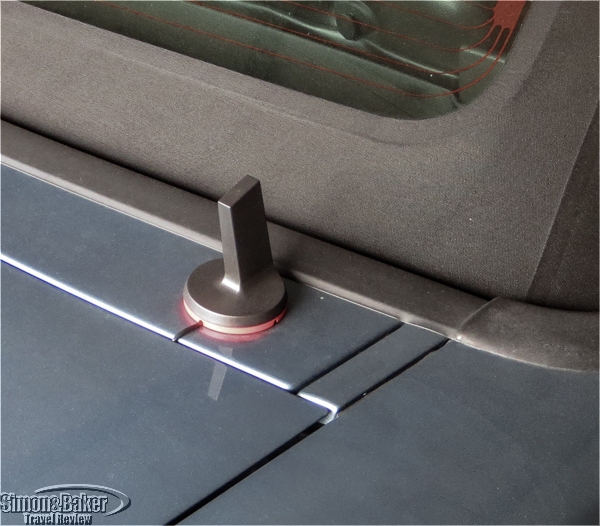
The magnetic antenna mount held securely between the trunk and the soft top
As soon as I placed a phone in the cradle, the effect of the booster was visible in the number of signal bars on the display. A hands free, either Bluetooth or wired is necessary for comfort and according to the user manual. The Federal Communications Commission (F.C.C.) requires that users never hold the device in the cradle up to their ears. Some local municipalities require the use of a hands free headset from drivings using a mobile phone. Our iPhone has the hands free jack on the top, so it had to be inserted into the cradle upside down. Once there it then remained in the spring loaded slot. After several trials with the new configuration, we managed to maintain calls while driving across the county without any drops or loss of signal, and the mobile phone worked in what previously were dead zones.
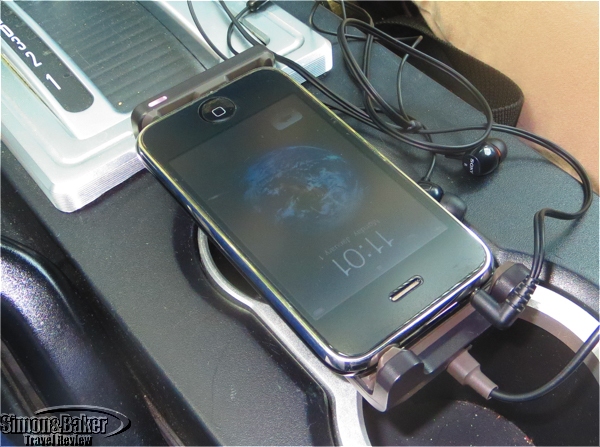
The phone secured in the cradle with the hands free cable attached.
According to the manufacturer, the boosted signal will extend battery life, which makes sense although we did not test it as a specific benefit. More than anything, it was nice to use the phone and maintain a conversation while running our errands or traveling, and reassuring to know that if we had an emergency or car trouble (other than a dead battery), we would be able to make a call even in the former dead zones. We have been satisfied with weBoost Drive Sleek Vehicle Signal Booster Kit and would recommend it to friends looking to increase the mobile phone signal in their cars.
Happy New Year!
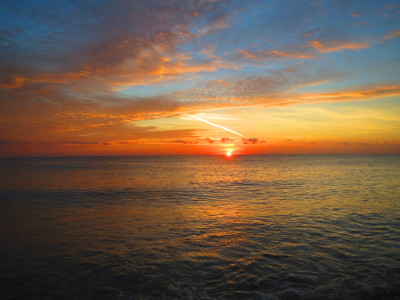
May your New Year be healthy, happy, and prosperous, and offer you rewarding experiences wherever you go!
Our French chocolate tasting in Manhattan’s Upper East Side
Article by Margot Liebman
Photos by Aaron Lubarsky
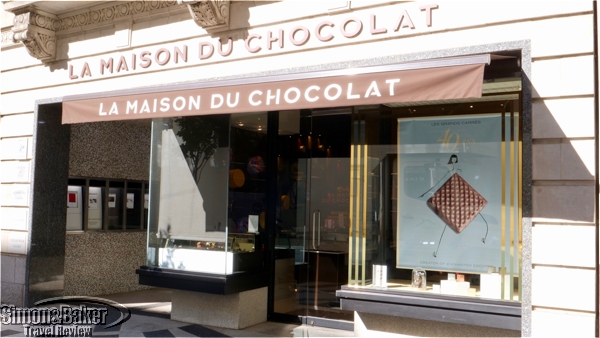
La Maison du Chocolat Madison Avenue store
We thought we knew chocolate until we tasted some of the products of La Maison du Chocolat (1018 Madison Avenue, New York, NY 10075, http://www.lamaisonduchocolat.us/la-maison/en_us, +1 718 361-9161), a French company. At the time of our tasting, in addition to locations in France and several in New York City, the company had shops in China, Japan, Korea, Kuwait, Macau, and United Kingdom.
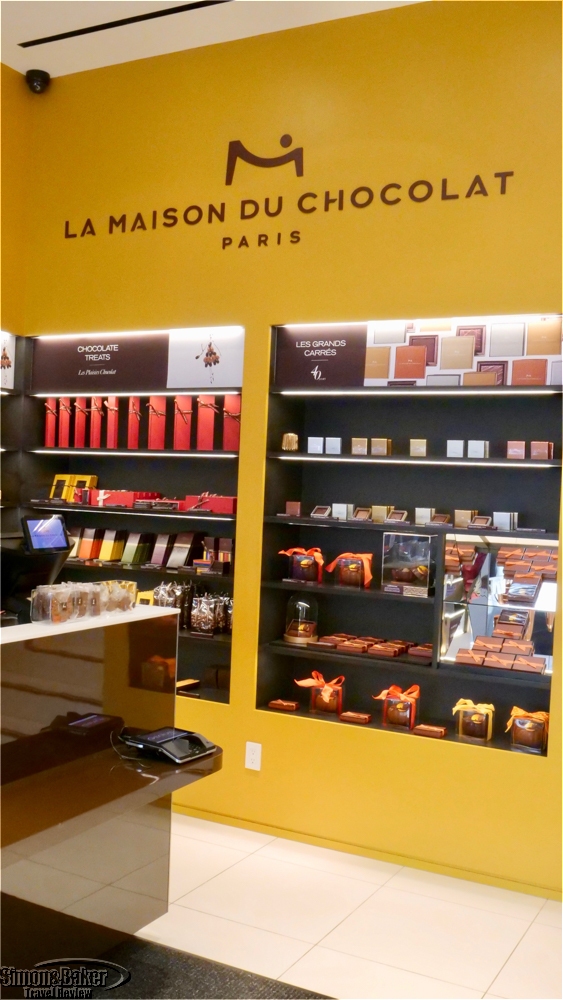
Inside the Madison Avenue store
We arrived on a cool, sunny morning in mid-October as the Madison Avenue store was opening. The city was just waking up, with people on their way to work and the streets starting to fill with the daily bustle. Located in an upscale neighborhood, La Maison du Chocolat’s boutique shared a block with prestigious clothing stores and cafes. During our visit, we each tasted six chocolate truffles, one macaron and two types of hot chocolate. We returned home with a box of six macarons (meringue and almond flour confections).

Macarons on display
At the front of the store shelves displayed various chocolate collections in signature dark brown boxes. There was also a counter with individual chocolates, as well as fresh pastries laid out in the window. The shelved collections of chocolate were organized by individual lines, including: Truffles, Maison Icons, Pralines, Chef’s Creation, Grand Carrés, Chocolate Treats, and the 40th Anniversary line. One of the friendly staff explained that the Maison Icons are the best selling line because they are the most well known, and come in boxes that may be customized.
The shop had the understated aesthetic we expected from a chocolatier: dark brown boxes, neatly organized chocolate truffles on display, and minimal decorations on the walls. In the back of the store there was a small café where we sampled six square chocolate truffles arranged in order of darkness. I started with Akosomno, the darkest chocolate. It was deep and smooth, and revealed an unexpected spicy note at the end. Next was Caracas, a bolder experience and by far the most intense. Boheme, the third on the plate, was the perfect harmony between milk chocolate and dark, the two notes came in and out as it melted on my tongue. I normally do not favor chocolate mixed with fruit, but Salvador was an exception. The dark chocolate mixed with an acidic raspberry ganache (a filling made from chocolate and cream) was tangy and exciting. Crystal touched all the notes evenly for a perfect flavor: it was a delicate blend of crispy, sweet, nutty praline wrapped in silky milk chocolate, finished with a touch of sea salt. Lastly, Grain Dentelle’s milk chocolate blended caramelized nuts and crispy pieces of crepes for a subtle, crunchy texture.
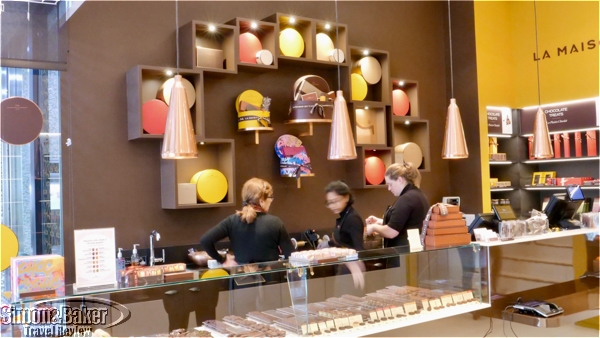
Busy staff behind the counter
It was early in the morning when we tasted the truffles, so we tried to restrain ourselves. We were unsuccessful. The chocolates were so rich and delicious, we ate most of what was on our plates.
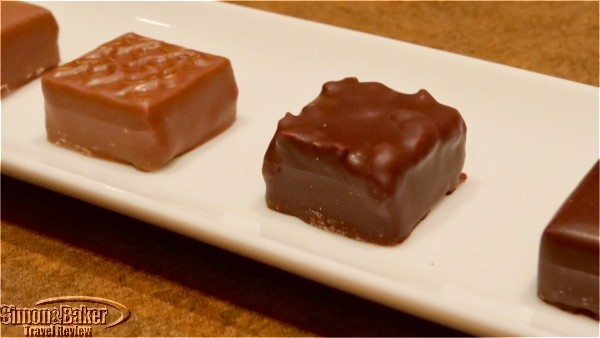
We sampled six chocolate truffles
We tried two types of hot chocolate. Guayaquil was like the luxury version of my childhood hot chocolate. It was creamy and sweet, but grounded by the gravitas of fine chocolate. Caracas was an unexpected experience for me. It had a full-bodied flavor with a light texture.
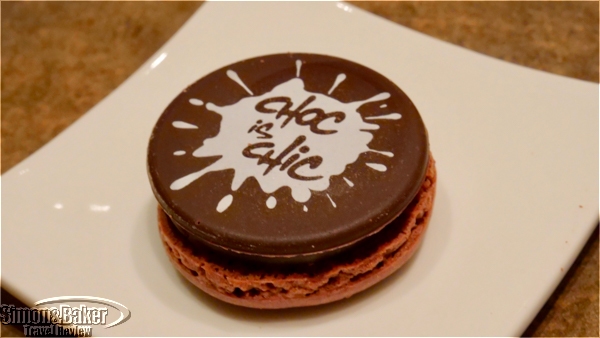
La Maison du Chocolat’s 40th anniversary limited edition macaron
We also sampled a La Maison du Chocolat’s 40th anniversary limited edition macaron, which was filled with dark unctuous ganache and subtle passion fruit within a thin and crunchy chocolate disk and soft, chewy cookie.

In the cafe in the back of the store we sampled six chocolate truffles arranged in order of darkness
As we indulged in the tasting, the staff recounted the story of La Maison du Chocolat, and the reasons they believe their chocolate is so special. Rami Sarabi, country manager, told us that ganache is the secret. Robert Linxe, who founded La Maison in 1977, was known as the “Sorcerer of Ganache.” Linxe insisted on making chocolate the old-fashioned way, which takes three days, according to Sarabi. The result, he said, should be a perfect balance between silkiness and richness. We found this to be true. The flavors came in waves as the ganache melted, making for a layered and sophisticated experience.
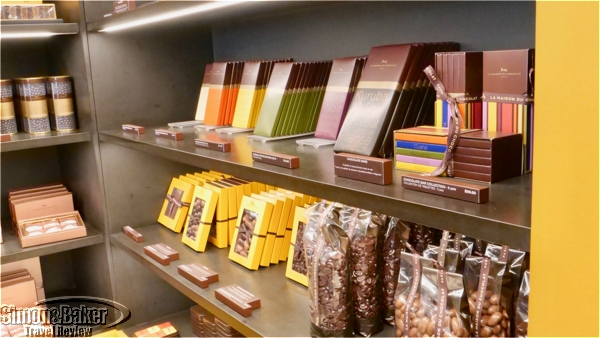
One of the display cases
Before Linxe passed away, he appointed his protégé, Nicolas Cloiseau, head chef. Today, Cloiseau oversees over thirty chefs. According to the staff, the chocolate on sale at the company shops was made in France following meticulous, traditional methods, and shipped to the various stores around the world.

Rami Sarabi, country manager, and Eva Rousseaux, manager, Marketing
We were pleased to learn from Rami that all of the cocoa in the shop was from sustainable sources. The staff reported that they could trace each piece of chocolate back to the exact location from which the bean was harvested. We tasted three macaron flavors, Quito, Maracuja, and Rigoletto. Each macaron, we were told, was made in France and shipped to the various stores worldwide. The ones we sampled were not refrigerated. After a week on our shelf they remained fresh. The wafers were soft with a chewy texture, and melted on the tongue.
Quito was an airy and sweet milk chocolate wafer, a perfect compliment to the dark chocolate ganache. The passion fruit of the Maracuja macaron was tangy, its tropical tones highlighting the deeper notes of the ganache. The Rigoletto brought me back to a traditional flavor, with the middle-sweetness of caramel. In addition to being delicious, the macarons looked delightful lined up together.
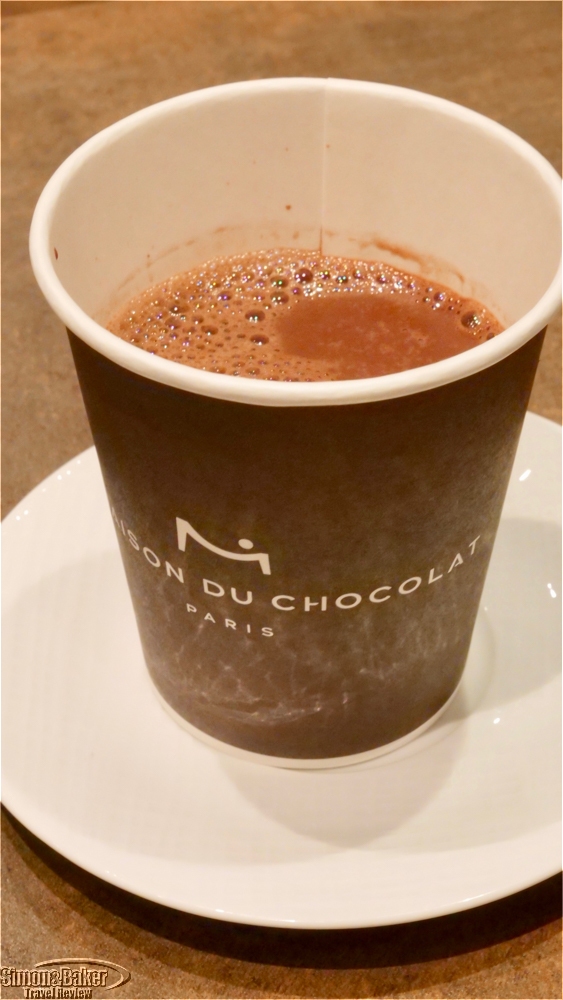
Our hot chocolate was served in disposable cups.
We loved the rich taste and high quality of the chocolates at La Maison du Chocolat, as well as the luxurious experience of the boutique itself. We plan to return to the shop, sit in the café, close our eyes, and be swept away by the complex flavors.
